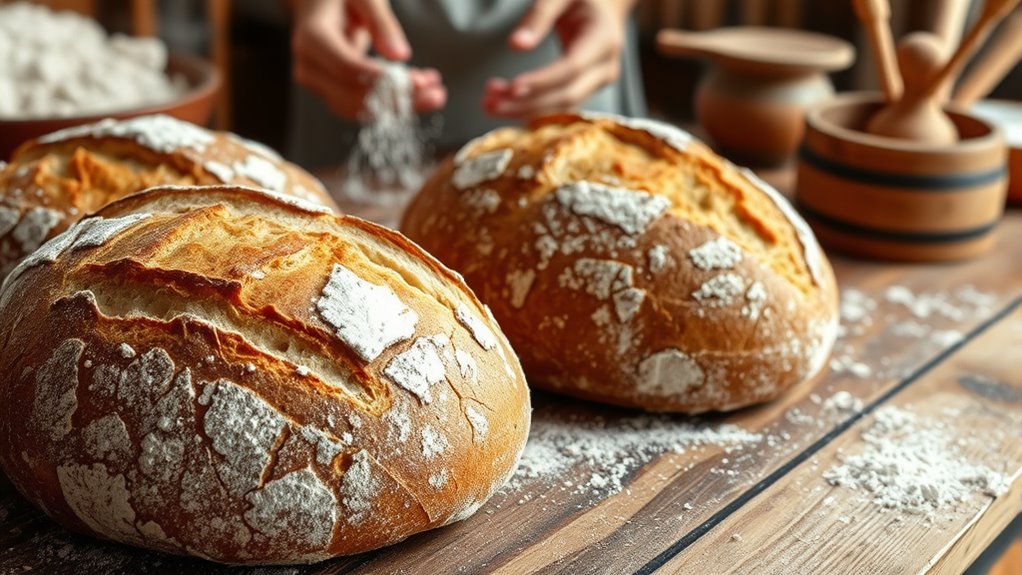The sourdough renaissance is a celebration of authentic, handcrafted bread built on traditional fermentation methods. It emphasizes craftsmanship, patience, and natural processes, using wild starter cultures to create complex flavors and textures. This movement reconnects with centuries-old techniques that highlight quality and authenticity over convenience. By choosing artisanal bread, you support a rich cultural heritage and a slower, more mindful approach to baking. If you keep exploring, you’ll uncover the fascinating craftsmanship behind every loaf.
Key Takeaways
- The resurgence of artisanal sourdough bread emphasizes traditional craftsmanship and natural fermentation processes.
- Cultivating and maintaining starter cultures is central to creating distinctive, flavorful sourdough loaves.
- Slow fermentation enhances bread flavor, texture, and crust through controlled environmental techniques.
- The sourdough renaissance reconnects bakers with historic practices, emphasizing patience, simplicity, and authenticity.
- This movement elevates breadmaking from routine to art, celebrating cultural heritage and artisanal skill.

Have you ever wondered what makes artisanal bread so special? It’s the deep-rooted craftsmanship, the careful attention to detail, and most importantly, the natural processes behind its creation. At the heart of authentic artisanal bread is the use of starter cultures—living communities of wild yeast and bacteria—that serve as the foundation for fermentation. These cultures aren’t just ingredients; they’re the soul of traditional breadmaking. When you start with a well-maintained starter, you’re tapping into a centuries-old tradition that transforms simple flour and water into complex, flavorful loaves. The secret lies in mastering fermentation techniques, which involve controlling temperature, hydration, and timing to coax the best flavors from your starter.
Fermentation is where the magic truly happens. Unlike commercial bread that uses instant yeast for quick rise, artisanal bread relies on slow fermentation, giving the dough time to develop depth and character. This process allows natural microorganisms to break down the starches and proteins in the flour, producing organic acids and aromatic compounds that contribute to the bread’s tangy flavor, chewy texture, and crusty exterior. By carefully managing fermentation techniques, you influence every aspect of the bread — from its rise to its flavor profile. You might warm the dough slightly to speed up fermentation or keep it cooler for a longer, more nuanced development. Each variation produces a different flavor, aroma, and texture, making every loaf a unique experience.
Using starter cultures requires patience and attention. You’ll nurture your starter daily, feeding it with flour and water, watching it bubble and develop complexity over time. This ongoing process creates a living culture that reflects your environment and your care. When you incorporate it into your dough, you’re not just baking bread; you’re cultivating a living organism that imparts distinctive qualities to each loaf. This symbiosis between culture and technique elevates breadmaking from a routine task to a craft. The fermentation techniques involved are nuanced, involving trial and error, but the rewards are worth it: bread that boasts a rich, tangy flavor and a satisfying texture that store-bought options can’t match.
In essence, the artisanal bread renaissance is about reconnecting with these traditional practices—using starter cultures and fermentation techniques passed down through generations. It’s about embracing patience, understanding natural processes, and appreciating the complexity that simple ingredients can produce. When you master these elements, you’re not just baking bread; you’re reviving a centuries-old culture that celebrates flavor, craftsmanship, and authenticity.
Frequently Asked Questions
How Do I Start My Own Sourdough Starter at Home?
To start your own sourdough starter at home, mix equal parts flour and water in a jar. Stir daily to encourage the fermentation process, which develops natural yeast and bacteria. Keep it at room temperature and discard some to maintain the balance. Regular starter maintenance involves feeding it with fresh flour and water, ensuring it stays active and bubbly for baking delicious artisanal bread.
What Are the Key Differences Between Sourdough and Commercial Bread?
You’re comparing apples and oranges when you look at sourdough and commercial bread. Sourdough involves a natural fermentation process, giving it a tangy flavor and better digestibility, while commercial bread relies on instant yeast for quick rise. The key difference lies in ingredient quality and fermentation time, which enhance flavors and texture in sourdough. It’s a slow dance that pays off, making your bread truly special.
How Has Social Media Influenced the Artisanal Bread Movement?
Social media has substantially boosted the artisanal bread movement by allowing you to share visual storytelling of your baking process, inspiring others worldwide. Influencer collaborations help popularize sourdough techniques and unique loaf designs, making artisanal bread more accessible and trendy. You can see new ideas, learn tips, and connect with a passionate community, all of which encourages more people to embrace the craft and elevate the artisanal bread culture.
What Are Common Mistakes Beginners Make With Sourdough Baking?
You often overproof your dough or use improper hydration, which can lead to dense or flat bread. To avoid these mistakes, keep an eye on proofing times and learn to recognize when the dough is just right—puffy but not collapsing. Also, measure your water carefully, ensuring the dough has the proper hydration level. This way, your sourdough will develop a better crumb and crust every time.
Are There Health Benefits Unique to Artisanal Sourdough Bread?
Imagine a slice of artisanal sourdough bread, its crust golden and inviting. You gain gut health benefits from the natural fermentation process, which breaks down gluten and enhances nutrient absorption. Unlike industrial bread, this fermentation boosts your digestion and may reduce inflammation. By choosing sourdough, you’re not just enjoying flavor but also supporting your overall well-being through unique fermentation benefits that promote a healthier gut.
Conclusion
As you explore the sourdough renaissance, you’ll see how artisanal bread is making a comeback, reconnecting us with tradition. Did you know that the artisanal bread market has grown by over 50% in the past five years? This surge shows just how much people crave authentic, handcrafted bread. So, whether you’re baking at home or supporting local bakeries, you’re part of a movement reviving a centuries-old craft that’s sweeter than ever.









